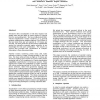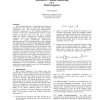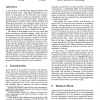91
Voted
VISUALIZATION
1991
IEEE
15 years 4 months ago
1991
IEEE
Interactive direct visualization of 3D data requires fast update rates and the ability to extract regions of interest from the surrounding data. We have implemented MultiValued Cl...
103
Voted
SIGGRAPH
1991
ACM
15 years 4 months ago
1991
ACM
Direct volume rendering o ers the opportunity to visualize all of a three-dimensional sample volume in one image. However, processing such images can be very expensive and good qu...
138
click to vote
VVS
1995
IEEE
15 years 4 months ago
1995
IEEE
Interpolating discrete volume data into a continuous form adapts implicit surface techniques for rendering volumetric iso-surfaces. One such algorithm uses the Lipschitz condition...
173
Voted
KDD
2000
ACM
15 years 4 months ago
2000
ACM
The grand tour, one of the most popular methods for multidimensional data exploration, is based on orthogonally projecting multidimensional data to a sequence of lower dimensional...
104
Voted
CGI
2004
IEEE
15 years 4 months ago
2004
IEEE
3D texture-based volume rendering is a popular way of realizing direct volume visualization on graphics hardware. However, the slice-oriented texture memory layout of many current...
179
click to vote
SI3D
1992
ACM
15 years 4 months ago
1992
ACM
Direct volume rendering is a computationally intensive operation that has become a valued and often preferred visualization tool. For maximal data comprehension, interactive manip...
118
Voted
SI3D
1992
ACM
15 years 4 months ago
1992
ACM
Recent advances in software and hardware technology have made direct ray-traced volume rendering of 3-d scalar data a feasible and effective method for imaging of the data's ...
122
Voted
VVS
1996
IEEE
15 years 4 months ago
1996
IEEE
A critical issue in understanding high speed flows is the study of shock waves. This paper summarizes our research on techniques for the detection and visualization of shock waves...
92
Voted
VISUALIZATION
1996
IEEE
15 years 4 months ago
1996
IEEE
This case study describes a system that allows the use of interactive volume rendering for routine clinical diagnosis. In this setup, a SGI RealityStation acts like a remote rende...
102
Voted
VISUALIZATION
1996
IEEE
15 years 4 months ago
1996
IEEE
This can be a costly operation. When the data is arranged according to its three-dimensional coordinates, calculating the contour surfaces requires examining each data cell. Avoidi...



